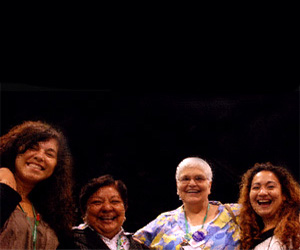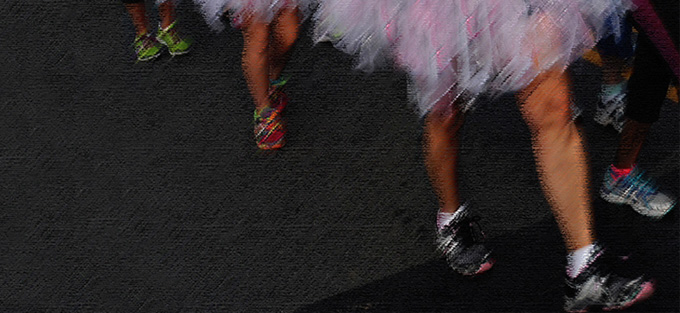by Christina Auch
“I feel like Pinocchio,” I joked with the nurse administering my chemotherapy at the hospital. With an IV line in my foot, and another one in my arm, oxygen cannulas and an oximeter on my finger, I could have been a human-sized marionette. I was 26, married for three years and the mother of a 1-year old daughter when I was diagnosed with stage 2B Hodgkin’s Lymphoma.
Thankfully, 18 years later, I remain cancer-free. While my experience taught me more about cancer, chemotherapy and radiation than any 20-something wants to know, it also taught me that healing and wholeness are not only physical. Wellness has dimensions that are intellectual, emotional, social and spiritual.
The prayerful prognosis
At first, the highest priority for my family and me was to collect information about my disease, my diagnosis and the treatment plan. But quickly, we discovered it was equally important to be surrounded and carried in prayer by our faith community that also met physical needs for regular meals and transportation and helped with childcare for our daughter.
It was important to find respite care for my husband and daughter so they could rest and know I was cared for. It was important for me to be in conversation with other patients too.
The chaplain at the community hospital where I received my radiation treatment organized a support group that I attended and together we walked in my first “Relay for Life,” an event that raises money for the American Cancer Society.
Caring in a congregation
 This period also was my first experience of what it meant to receive care from those in my faith community. What my family and I remember are the people who walked alongside us. They were people in our congregation from our Sunday morning Bible study, the mothers of preschoolers group and our community like the nursing staff, the chaplain and my husband’s colleagues.
This period also was my first experience of what it meant to receive care from those in my faith community. What my family and I remember are the people who walked alongside us. They were people in our congregation from our Sunday morning Bible study, the mothers of preschoolers group and our community like the nursing staff, the chaplain and my husband’s colleagues.
Remarkably, we had only been in that community less than two months when I was diagnosed, so these weren’t longstanding, deeply personal friendships; they were relationships rooted in the belief that we are called to love our neighbors.
The outcome
My remission is an outcome of medical science, but my wellness, my healing from cancer, bears witness to the care and attention that all of these people in my community provided.
Dr. Melvin Steinbron, author of Can the Pastor Do It Alone? defines pastoring as, “Caring for one another by giving one’s self in Christian love to a relationship in times of weakness and times of strength.”
At the church where I served my internship before becoming a pastor, there was an active lay ministry that provided pastoral care through prayer, card ministries, phone calls and face-to-face visitation and by bringing communion to people who are not able to get to church. The relationships are confidential because trust is integral to building relationships and being vulnerable with one another. This ministry affirms the role of every person in a congregation to care for one another.
I became a health promoter in the congregation I serve. We are advocates who foster a partnership between health providers, educators and faith communities with an emphasis on building ongoing relationships. We affirm that health and wellness education and activities have an important place within practicing faith.
One of the joys during the training was reflecting on how many congregations like mine that are already are caring for one another in many ways.
How we support each other
In our congregations, we care for others creatively through prayer shawl and quilt ministries and emotionally through cards, prayer, grief and crisis ministries. We care for others physically through feeding, clothing and providing transportation; and we support others socially through visitation and fellowship.
We also use our imaginations to think about how we might encourage healthy choices and awareness of risk behaviors in our congregations. We ask for more fresh vegetables and fruit at shared meals. We walk together or open unused spaces for group exercise. We provide health education on child safety, parenting, women’s health issues, smoking cessation, caring for aging parents, grief and loss. Or we sponsor a blood drive with the American Red Cross, or a mammogram or pre-diabetes screening through our local hospital.
In the epistle 3 John, the author writes to another, “Beloved, I pray that all may go well with you and that you may be in good health, just as it is well with your soul” (3 John 1:1-2). I am confident that, as we increase our own awareness of how faith and our wellness are connected individually and in our congregations, we are strengthened to serve our neighbors and community in ministry.
Discussion Questions
1. How have you experienced or witnessed care provided in your faith community?
2. What are the obstacles to talking about wellness in our faith communities?
3. What are the immediate needs where you live, work or worship?
4. How can we encourage healthy choices in our congregations and neighborhoods?
Closing Prayer
Lord of life, thank you for creating us to live in relationship with you and with each other. Heal our broken bodies, minds and spirits. Teach us to care for ourselves and each other as you care for us. Show us how to show your love to our congregations, communities and in the world by tending to the many dimensions of wellness and wholeness. Amen.
The Rev. Christina Auch is an ELCA pastor at Ascension Lutheran Church in Shelby, N.C., and celebrated 17 years in remission from cancer earlier this year.


I too received loving care from a congregation in Omaha,NE.
I received my chemo and transplant there and needed to stay in the city for 100 days after my transplant. Bethel Lutheran provided 24/7 care except for days when my husband could come to Omaha.
We moved to Omaha later and became members of Bethel. I thank God for all of them. They didn’t even know me – I was a complete stranger and they came and took care of me
So appreciate this beautiful and helpful word from Chris. I have known her for more than five years, and didn’t know this story. I appreciate her healthy and faithful witness all the more.